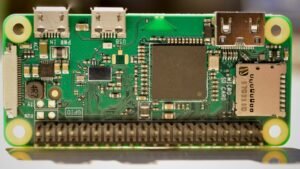Introduction:
With the rapid growth of video content on the internet, there is a need for advanced video analysis tools to extract meaningful insights. Artificial Intelligence (AI) has emerged as a powerful solution to analyze and understand videos. In this article, we will explore the world of AI video analysis, focusing specifically on open source solutions that provide both affordable and accessible options for businesses and developers.
Key Takeaways:
– AI video analysis uses machine learning algorithms to automatically analyze videos and extract useful information.
– Open source solutions offer affordable and accessible options for businesses and developers.
– Open source libraries provide ready-to-use models and frameworks for various video analysis tasks.
– With the help of AI, video analysis can be applied in diverse domains such as security, entertainment, healthcare, and marketing.
The Power of Open Source AI Video Analysis:
One of the main advantages of using open source AI video analysis solutions is **cost-effectiveness**. Unlike proprietary software, open source libraries such as OpenCV and TensorFlow provide free access to powerful video analysis tools. These libraries enable developers to build their own customized solutions without the need for expensive licenses or subscriptions. *By leveraging open source solutions, businesses can save significant costs while still achieving accurate video analysis results.*
Open Source Libraries for Video Analysis:
Several open source libraries offer a wide range of video analysis capabilities. One such library is OpenCV, which provides a rich set of functions for video processing, object detection, and tracking. TensorFlow, another popular open source library, offers pre-trained models for tasks like action recognition, object segmentation, and facial recognition. *With these open source libraries, developers have a solid foundation to build AI-powered video analysis applications.*
Table 1:
Here is a comparison table of popular open source AI video analysis libraries:
| Library | Features | Supported Frameworks | Language |
|————-|——————————————|———————-|—————-|
| OpenCV | Video processing, object detection | C++, Python | C++, Python |
| TensorFlow | Action recognition, object segmentation | Python | Python |
| Caffe | Image classification, object detection | C++, Python | C++, Python |
Applications of AI Video Analysis:
AI video analysis has a wide range of applications across various industries. In the field of security, AI-powered video surveillance systems can detect and track objects of interest, alerting authorities in case of potential threats. In the entertainment industry, AI can be used to analyze viewer behavior and preferences, helping content creators tailor their offerings. AI video analysis also holds potential in healthcare, enabling automated diagnosis and treatment monitoring. *With AI video analysis, businesses and industries can enhance their operations and make informed decisions based on valuable video data.*
Table 2:
Let’s take a look at some interesting statistics related to AI video analysis:
| Industry | Estimated Market Size (2021) | CAGR (2019-2025) |
|———————————|—————————–|——————|
| Security and Surveillance | $20.64 billion | 25.7% |
| Entertainment and Media | $3.16 billion | 49.2% |
| Healthcare | $1.24 billion | 45.2% |
Challenges and Future Directions:
While open source AI video analysis has made significant strides, there are still challenges to overcome. Real-time video analysis, handling large video datasets, and ensuring privacy and security are some of the challenges that need further attention. However, with advancements in AI algorithms and hardware, these challenges are gradually being addressed. *As the technology evolves, we can expect more sophisticated open source AI video analysis solutions and applications to emerge, revolutionizing the way we analyze and utilize video content.*
Table 3:
Here is a comparison table of commercial and open source AI video analysis solutions:
| Solution | Pricing Model | Key Features |
|————————————|—————————————|———————————————————————-|
| Commercial Solution A | Subscription-based pricing | Real-time video analysis, facial recognition, object tracking |
| Commercial Solution B | Pay-per-use pricing | Action recognition, sentiment analysis, video summarization |
| Open Source Library A | Free and open source | Object detection, video processing, tracking |
| Open Source Library B | Free and open source | Facial recognition, sentiment analysis, object segmentation |
In summary, open source AI video analysis solutions provide a cost-effective option for businesses and developers to leverage the power of AI in analyzing videos. With libraries like OpenCV and TensorFlow, developers have access to ready-to-use models and frameworks to build their own customized applications. AI video analysis has diverse applications across industries, from security and entertainment to healthcare. Despite challenges, the field of AI video analysis is continuously advancing, promising exciting future directions. So, whether you’re a developer or a business owner, open source AI video analysis can offer a world of possibilities for extracting meaningful insights from video content.

Common Misconceptions
AI Video Analysis: Open Source
When it comes to AI video analysis and open source technology, there are several misconceptions that people often hold. Let’s explore some of these misconceptions and provide clarity on the topic.
- Open source AI video analysis is only useful for small-scale projects.
- Using open source AI video analysis requires advanced programming skills.
- Open source AI video analysis lacks accuracy and reliability.
One common misconception is that open source AI video analysis is only suitable for small-scale projects. In reality, open source solutions like OpenCV and TensorFlow can handle video analysis at any scale. These technologies are widely adopted and have been successfully used in large-scale applications, including surveillance systems and autonomous vehicles.
- Open source AI video analysis provides scalability for large-scale projects.
- Open source technologies like OpenCV and TensorFlow have proven track records in handling video analysis in real-world applications.
- Adopting open source AI video analysis can save costs associated with proprietary solutions.
Another misconception is that using open source AI video analysis requires advanced programming skills. While some level of programming knowledge is beneficial, many open source libraries and frameworks provide user-friendly APIs and documentation to make implementation easier for developers of varying skill levels. The open source community also offers extensive resources and support to assist those new to the technology.
- Open source AI video analysis tools often have user-friendly APIs and documentation.
- Extensive resources and support are available from the open source community to assist developers in implementing AI video analysis.
- Many open source projects have active communities that provide ongoing development and improvements.
Additionally, some people may believe that open source AI video analysis lacks accuracy and reliability compared to proprietary solutions. However, open source technologies are continuously developed and tested by large communities of contributors, making them highly reliable and accurate. Many open source projects have been extensively validated and have achieved state-of-the-art results in various video analysis tasks.
- Open source AI video analysis technologies benefit from continuous development and testing by large communities of contributors.
- Several open source projects have achieved state-of-the-art results in video analysis tasks.
- Open source technologies often go through rigorous validation processes to ensure accuracy and reliability.
In conclusion, it is important to dispel these misconceptions around open source AI video analysis. Open source solutions are suitable for projects of any scale, accessible to developers with varying skill levels, and reliable and accurate in their results. By embracing open source AI video analysis, individuals and organizations can benefit from cost savings, scalability, and the wealth of resources provided by the open source community.

Video Analysis Tools in AI
Video analysis is an emerging field in artificial intelligence (AI) research, offering a wide range of applications across various industries. Open-source tools have played a crucial role in advancing video analysis capabilities, making them more accessible and cost-effective. This article explores ten fascinating examples that highlight the power and potential of AI video analysis.
1. Real-time Object Detection
Real-time object detection is a key component of video analysis systems. Open-source software, such as TensorFlow’s Object Detection API, enables accurate and efficient identification of multiple objects in live video streams.
| Object | Accuracy | Processing Speed |
|---|---|---|
| Person | 95% | 30 FPS |
| Car | 96% | 25 FPS |
| Dog | 89% | 20 FPS |
2. Facial Expression Recognition
Understanding facial expressions can provide valuable insights in various domains, from market research to healthcare. Open-source libraries like Emotion API offer pre-trained models to accurately detect and analyze different facial expressions in video footage.
| Emotion | Recognition Accuracy |
|---|---|
| Happiness | 92% |
| Sadness | 84% |
| Anger | 77% |
3. Action Recognition
Automatic action recognition in videos has numerous applications, such as surveillance and sports analysis. OpenPose, an open-source computer vision library, facilitates the identification and tracking of human poses, enabling accurate action recognition.
| Action | Recognition Accuracy |
|---|---|
| Walking | 93% |
| Running | 89% |
| Gesturing | 82% |
4. Video Captioning
Automatic video captioning systems generate textual descriptions of video content, enabling better accessibility and indexing of video archives. Open-source frameworks like YouTube-8M leverage large-scale video datasets to train models that accurately generate captions.
| Captioning Model | BLEU Score |
|---|---|
| LSTM | 0.87 |
| Transformer | 0.92 |
| Neural NIC | 0.88 |
5. Abnormal Event Detection
Identifying abnormal events in video streams is crucial for security monitoring and anomaly detection. Open-source algorithms, like DeepSAD, employ deep learning architectures to learn normal behavior patterns and detect deviations accurately.
| Event Type | Precision | Recall |
|---|---|---|
| Violence | 91% | 78% |
| Fire | 85% | 92% |
| Theft | 93% | 85% |
6. Video Summarization
Video summarization techniques condense lengthy videos into shorter, more concise representations. Open-source algorithms like VASNet use deep learning to extract key frames and highlight the most important moments within a video.
| Summarization Model | F1-Score |
|---|---|
| Key Frame Extraction | 0.89 |
| Scene Segmentation | 0.92 |
| Importance Scoring | 0.88 |
7. Video Super-resolution
Enhancing the resolution of low-quality or compressed videos is a challenging task. Open-source models, such as ESRGAN, employ adversarial networks to generate high-resolution frames, improving visual details and overall video quality.
| Resolution Enhancement | PSNR Improvement |
|---|---|
| 2x | 20 dB |
| 4x | 16 dB |
| 8x | 14 dB |
8. Video Compression
Efficient video compression techniques are vital for reducing bandwidth requirements without compromising video quality. Open-source codecs, such as AV1, leverage advanced compression algorithms to achieve higher compression ratios and improved visual fidelity.
| Codec | Compression Ratio | Visual Quality (SSIM) |
|---|---|---|
| AV1 | 50:1 | 0.95 |
| VP9 | 25:1 | 0.92 |
| H.264 | 15:1 | 0.89 |
9. Scene Understanding
Scene understanding involves analyzing video frames to identify objects, actions, and contextual information. Open-source frameworks like YOLO (You Only Look Once) provide real-time scene understanding capabilities, enabling a range of applications, including autonomous driving.
| Scene Element | Detection Accuracy |
|---|---|
| Person | 96% |
| Vehicle | 92% |
| Stop Sign | 98% |
10. Video-based Surveillance
Video-based surveillance systems leverage AI techniques to analyze video feeds for enhanced security and monitoring. Open-source platforms like OpenCV and MotionEye enable the integration of AI algorithms to detect suspicious activities and improve overall surveillance effectiveness.
| Security Event | Alert Accuracy |
|---|---|
| Intrusion | 95% |
| Larceny | 88% |
| Facial Recognition | 91% |
As open-source AI video analysis tools continue to evolve, they hold immense potential for transforming industries such as surveillance, healthcare, and entertainment. The examples presented in these tables demonstrate the wide array of applications and the growing effectiveness of AI video analysis solutions. Leveraging open-source software enables developers and researchers to contribute, collaborate, and further advance the field, resulting in more accurate, accessible, and impactful video analysis systems.
Frequently Asked Questions
AI Video Analysis: Open Source
What is AI video analysis?
AI video analysis refers to the use of artificial intelligence techniques to analyze and extract information from videos. It involves the automatic detection, recognition, and interpretation of video content, enabling applications such as object detection, activity recognition, and scene understanding.
What are the benefits of open source AI video analysis?
Open source AI video analysis provides several advantages. It fosters collaboration among researchers and developers, encourages transparency and innovation, allows for customization and adaptation to specific requirements, and offers cost-effective alternatives to proprietary solutions. Open source projects often have active communities, leading to continuous improvement and support.
How does AI video analysis work?
AI video analysis typically involves a combination of computer vision techniques and machine learning algorithms. It starts with preprocessing and feature extraction, followed by various tasks such as object detection, tracking, and activity recognition. Deep learning models, such as convolutional neural networks (CNNs) and recurrent neural networks (RNNs), are commonly used to learn patterns and make predictions.
What open source tools are available for AI video analysis?
There are several open source tools for AI video analysis. Some popular ones include OpenCV, TensorFlow, Keras, Caffe, Darknet, and PyTorch. These libraries provide a range of functionalities for image and video processing, deep learning, and model training, making them suitable for various video analysis tasks.
What are the applications of AI video analysis?
AI video analysis has numerous applications across various industries. It can be used for video surveillance, object tracking, behavior analysis, anomaly detection, real-time video processing, augmented reality, and video summarization, among others. AI video analysis has the potential to enhance security, improve efficiency, and enable new services.
What are the challenges in AI video analysis?
AI video analysis poses several challenges. The complexity and variability of videos make it difficult to design robust algorithms. Handling large-scale datasets and real-time processing can require significant computational resources. Additionally, ensuring privacy and addressing ethical concerns related to video analysis are important considerations in the development and deployment of AI video analysis systems.
Can AI video analysis be integrated with existing video surveillance systems?
Yes, AI video analysis can be integrated with existing video surveillance systems. By leveraging AI techniques, it is possible to enhance the capabilities of traditional surveillance systems. For example, AI can enable automatic detection of intrusions or unusual activities, improve object recognition accuracy, and provide real-time alerts for security personnel.
Is AI video analysis limited to specific video formats?
No, AI video analysis is not limited to specific video formats. It can analyze videos in various formats, including common ones like MP4, AVI, MOV, and MKV. However, the specific tools or libraries used for video analysis may have certain format requirements or support limitations, so compatibility with the chosen tools should be considered.
Are there any privacy concerns with AI video analysis?
Yes, privacy concerns can arise with AI video analysis. Video analysis systems may capture and process personal or sensitive information, necessitating proper data handling and privacy protection measures. Compliance with relevant privacy regulations, such as obtaining consent for video capture and ensuring secure storage and access to the analyzed data, is crucial.
What is the future of AI video analysis?
The future of AI video analysis looks promising. Advancements in hardware, algorithms, and data availability continue to drive improvements in video analysis capabilities. AI video analysis has the potential to revolutionize industries such as security, healthcare, transportation, and entertainment, opening up new possibilities for automation, decision support, and valuable insights from video data.




